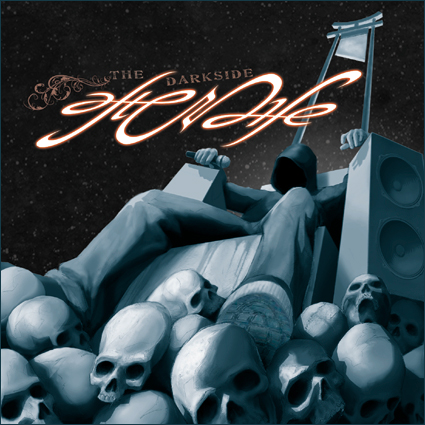The award for most transparent album name and CD packaging ever (narrowly beating out Tribe’s “Beats, Rhymes and Life” and perhaps Ice-T’s car, women and gun themed “Rhyme Pays” cover, respectively) goes to Afterlife’s debut album “The Darkside.” The black cover art depicts a hooded figure sitting ominously on a stone throne atop a pile of skulls (a la Cube during his most gothic thuggery), with a guillotine hanging curiously overhead in case anyone missed the death and destruction motif.
It’s blatant not only in what it wants to convey but (more importantly) what it implies to a discerning consumer. Yes, Afterlife wants to make you see he is horror(to the)core, a scary twisted so-and-so who revels in the doom and gloom of rainy days and axe murderers. However, the total package, taken in with a critical eye, is so over-the-top that it becomes more comical than menacing, a wicked self-parody (if only it wasn’t sincere).
Perfectly reflecting the music found inside, this extremism initially creates a visceral and well-understood vibe, but ultimately stifles and suffocates any real artistic expression. What we get is a full-length equally competent and uniform, both lyrically and sonically, so one-sidedly dark that the contrast is lost (cuz without day there’s no night, right?).
Here’s the sonic blueprint Afterlife and his Darkside co-horts use to produce their tracks: start with a simple and sinister organ or guitar synth loop. After five to ten bars, add in a funky but generic drum loop. Sprinkle on a serviceable but underwhelming bassline and perhaps a slight melodic flourish, and there you have it. Although most have initially momentum (after the beats comes in, that is), the painfully simple loops are quickly dug into the ground through mindless repetition, leaving the impressive rhymeflow and frequently animated drums to drown in monotony.
It’s clear the sonic crew is going for a uniformly dark trope of claustrophobia and disaster (similar to its possible name inspiration “Dare iz a Darkside”), but the rigid formula limits the effectiveness severely. Some tracks are more flavorful than others, but mostly it’s just fourteen slices of the same pizza.
Afterlife’s staccato flow is enjoyable to listen to, but his rage seems canned and his metaphors are stale, flaccid or just uninspired (“I’m like Lebron in overtime,” “I have a dream like Dr. King,” etc).
The subject matter doesn’t help either, because when he’s not dissing wack MC’s, his obsession with evil and pain never quite convinces; I couldn’t help but picture him writing these uber-horrific lyrics in a comfortable bedroom after a nice dinner. It’s as if he shows us all this rage but never reveals its source, thereby making it unjustified and superfluous. It also doesn’t help that he couldn’t write a catchy hook to save his (after)life.
The effectiveness of “Darkside” probably has more to do with who you are than with what it actually is. For an angsty teen mad at the world, this may just be the perfect soundtrack for all your deep dark thoughts. But for me, the self-seriousness of it all was ultimately overpowering and silly. As I’m sure Afterlife loves horrorcore rap more than most, he should’ve known to take a lesson from the best album that genre has produced, the Gravediggaz “6 Feet Deep”: a little tongue-in-cheek self-deprecation goes a long way.

